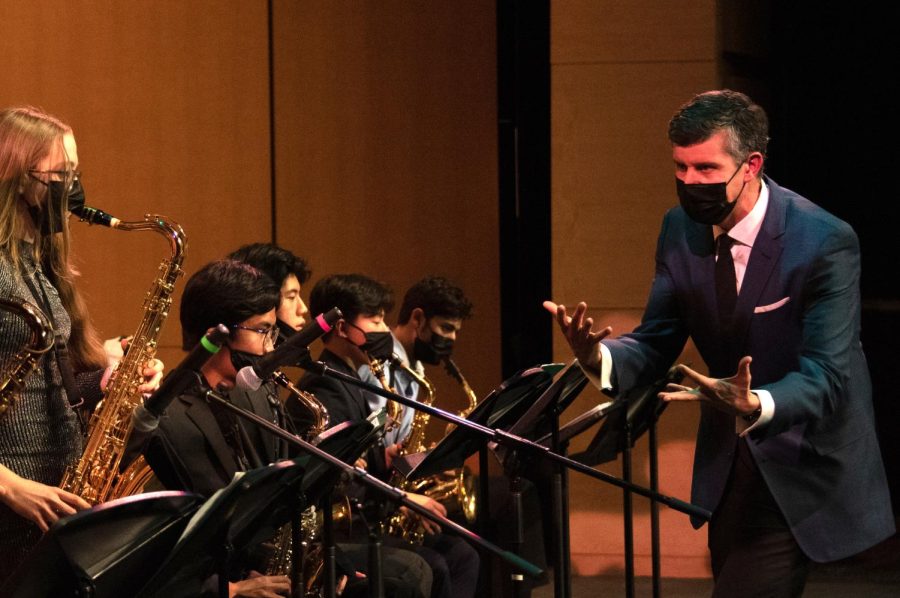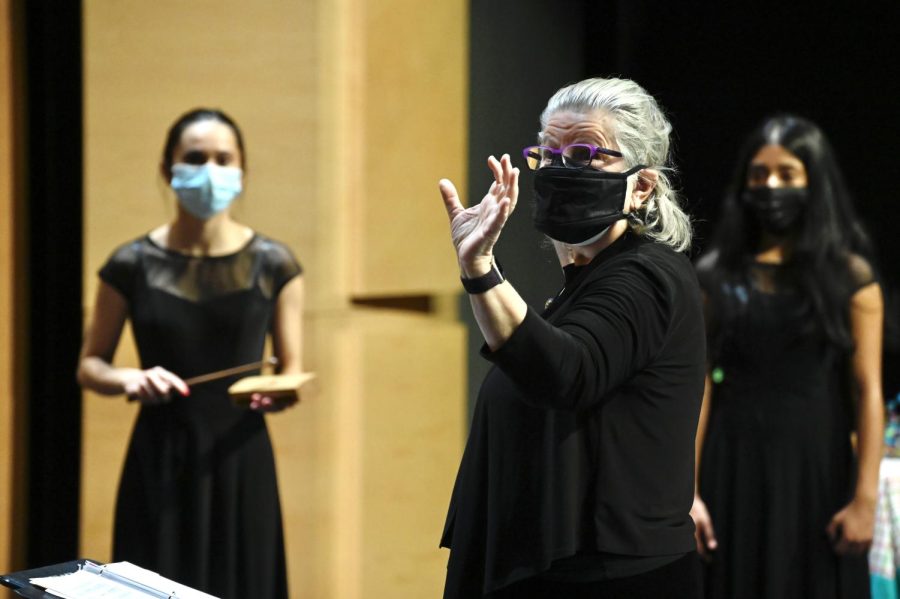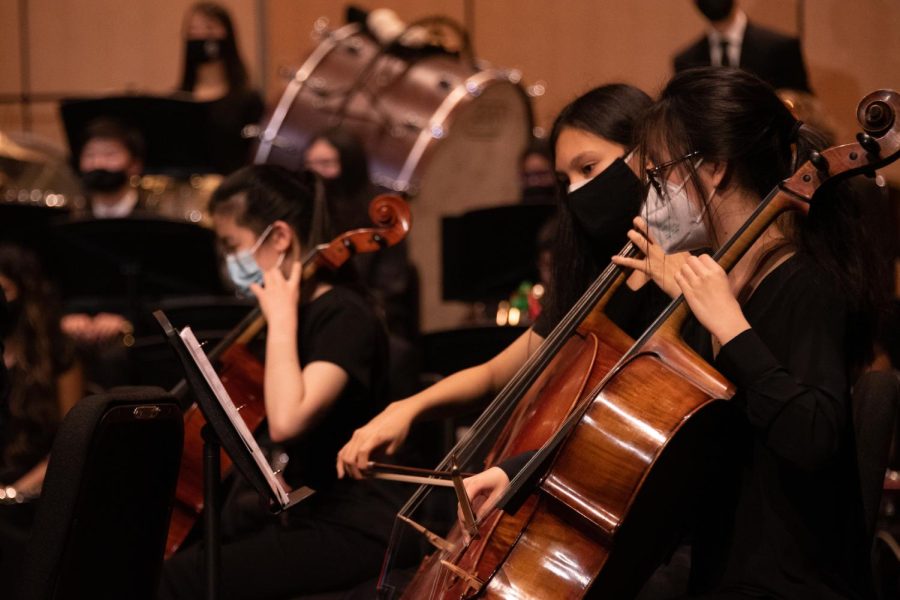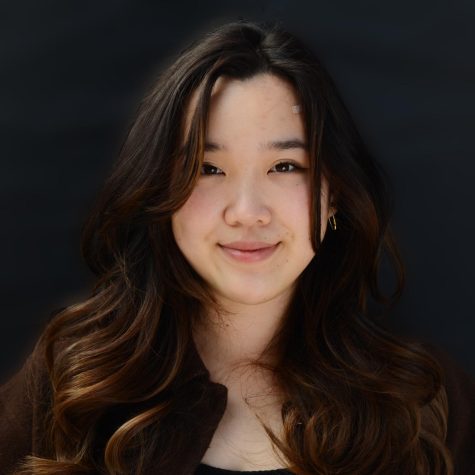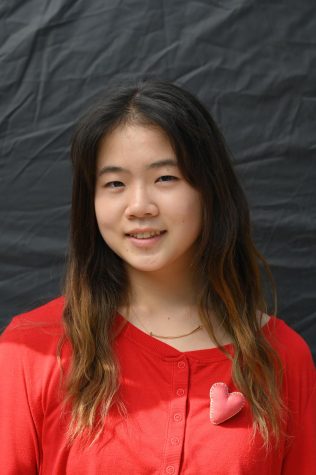Choral and instrumental ensembles kick off the year with first concerts of 2022
Upper school director of instrumental music Dr. David Hart conducts Jazz Band at the instrumental concert on Jan. 14. The winter vocal concert took place on Jan. 13, both in the Patil Theater of the Rothschild Performing Arts Center.
January 25, 2022
Upper school choral and instrumental ensemble members performed in the annual winter choral concert and winter instrumental concert, which took place in the Patil Theater at 7:00 p.m. on Jan. 13 and Jan. 14 respectively.
Bel Canto began the choral concert with David M. Kellermeyer’s “Music Alone Shall Live” before performing Claudio Monteverdi’s “Pur ti miro” from L’incoronazione di Poppea and Ken Berg’s “Galop” from Solfege Suite. According to Bel Canto soprano vocalist Maryam Zehra (10), “Music Alone Shall Live” symbolized choir members’ resilience through the pandemic.
“For everyone in our choir, ‘Music Alone Shall Live’ was the first piece that we sang,” Maryam said. “The meaning behind the song really resonated with us: with COVID-19 and us being online, the only thing that did stay with us the whole time was music.”
Camerata then joined Bel Canto for their joint performance of Michael Isaacson and Susan Nurenberg’s “Light the Legend.” Afterwards, Camerata performed Orazio Vecchi’s “Fa Una Canzona” and Amy Feldman Bernon’s “Alleluia, Alleluia!”
Cantilena’s section of the concert featured the debut of three Cantilena alumni who now teach at Harker: Upper school English teacher Bridget Nixon, middle school science department chair Kathy Peng and upper school journalism teacher Whitney Huang. The three joined Cantilena in a performance of Frode Fjellheim’s “Eatnemen Vuelie,” then sang “Truth” by Andrea Ramsey as a trio. Cantilena closed the show with Gustav Holst’s “Hymn to Vena” from “Hymns from the Rig Veda,” his translation of the Rig Veda into English.
“I try to find music that fits the culture of the kids in my ensemble, particularly here at Harker because we have a lot of first-generation Americans, hyphenated Americans — Chinese, Japanese, Indian, Russian,” said Susan Nace, upper school vocal music teacher and director of the choral concert.
Pandemic protocols presented challenges for choral students when preparing for the concert. All members were required to wear masks while practicing and performing together, which cut down on vocal projection and limited their facial expressions.
“One song we sang, ‘Galop,’ has a lot of key changes, and we try to show that through our eyes and eyebrows,” Maryam said. “It’s a little bit difficult because you can’t see the rest of your face so [we] focus on really widening [our] eyes.”
On Friday, Lab Band opened the instrumental concert with Miles Davis’ “Four” and Freddie Hubbard’s “Sky Dive.” They then moved on to “Round Midnight” by Thelonius Monk, an especially challenging arrangement involving complicated chord changes, and finished with “Cold Duck Time” by Eddie Harris.
Jazz Band took the stage next — Aaron Tran (12) and Camilla Lindh (12) performed solos on the saxophone, while Kai Burich (12) played lead trumpet with Malar Bala (12) on vocals. Pieces included Oscar Pettiford’s “Blues in the Closet,” Antonio Carlos Jobim’s “Chega de Saudade,” Erroll Garner’s “Misty” and Thelonious Monk’s “Well You Needn’t.”
Orchestra rounded out the concert with Gioachino Rossini’s “The Barber of Seville,” which was followed by a solo performed by principal cellist Lucas Chen (12) and conducted by Jaco Wong, upper school orchestra co-conductor.
“The Shostakovich [concerto] is very powerful and musical,” Lucas said. “Performing is where you [get to] show the style that the composer wanted. [When you] get a piece that’s so musical, where you don’t really have to focus on the notes as much, you can focus on the character that you play with.”
Finally, five members of Jazz Band, Varun Fuloria (10), Jack Yang (10), Will Lee (11), Kai Burich (12) and Aaron Tran (12), joined Orchestra to play Leornard Bernstein’s “Symphonic Dances from West Side Story.” Dr. David Hart, upper school Director of Instrumental Music, noted how the blend of jazz and orchestra music in the piece required coordination between all members involved.
“[‘Symphonic Dances’] is a culmination,” Dr. Hart said. “It takes every single person on that stage playing different parts together to make it work: It shows teamwork at the highest level.”
With stricter county recommendations regarding indoor activities in the fall, instrumental students had to set up in the Rothschild Performing Arts Center’s (RPAC) lobby early each morning for practice instead of their classrooms, where space was limited. Moreover, with the rise of the omicron variant, members of ensembles had to miss practice after testing positive.
Despite the difficulties preparing for the concert and performing live, the performers’ hard work after a year of quarantine ensured successful shows.
“We need to sing, and our audiences need live music,” Nace said. “There was a parent who commented, ‘I didn’t realize how much I missed live music until I came to the concert last night.’”
Dr. Hart agreed with Nace on the significance of live music and its unique ability to bring people together in challenging circumstances.
“Music is a form of interaction and connection that is hard to replicate in any other way than being in person,” Dr. Hart said. “To me, not only [was] this a moment for all instrumental ensembles to perform together in one concert, it [was] really a celebration of resilience and figuring out how to keep music going through this pandemic.”




![LALC Vice President of External Affairs Raeanne Li (11) explains the International Phonetic Alphabet to attendees. "We decided to have more fun topics this year instead of just talking about the same things every year so our older members can also [enjoy],” Raeanne said.](https://harkeraquila.com/wp-content/uploads/2025/10/DSC_4627-1200x795.jpg)


















![“[Building nerf blasters] became this outlet of creativity for me that hasn't been matched by anything else. The process [of] making a build complete to your desire is such a painstakingly difficult process, but I've had to learn from [the skills needed from] soldering to proper painting. There's so many different options for everything, if you think about it, it exists. The best part is [that] if it doesn't exist, you can build it yourself," Ishaan Parate said.](https://harkeraquila.com/wp-content/uploads/2022/08/DSC_8149-900x604.jpg)




![“When I came into high school, I was ready to be a follower. But DECA was a game changer for me. It helped me overcome my fear of public speaking, and it's played such a major role in who I've become today. To be able to successfully lead a chapter of 150 students, an officer team and be one of the upperclassmen I once really admired is something I'm [really] proud of,” Anvitha Tummala ('21) said.](https://harkeraquila.com/wp-content/uploads/2021/07/Screen-Shot-2021-07-25-at-9.50.05-AM-900x594.png)







![“I think getting up in the morning and having a sense of purpose [is exciting]. I think without a certain amount of drive, life is kind of obsolete and mundane, and I think having that every single day is what makes each day unique and kind of makes life exciting,” Neymika Jain (12) said.](https://harkeraquila.com/wp-content/uploads/2017/06/Screen-Shot-2017-06-03-at-4.54.16-PM.png)








![“My slogan is ‘slow feet, don’t eat, and I’m hungry.’ You need to run fast to get where you are–you aren't going to get those championships if you aren't fast,” Angel Cervantes (12) said. “I want to do well in school on my tests and in track and win championships for my team. I live by that, [and] I can do that anywhere: in the classroom or on the field.”](https://harkeraquila.com/wp-content/uploads/2018/06/DSC5146-900x601.jpg)
![“[Volleyball has] taught me how to fall correctly, and another thing it taught is that you don’t have to be the best at something to be good at it. If you just hit the ball in a smart way, then it still scores points and you’re good at it. You could be a background player and still make a much bigger impact on the team than you would think,” Anya Gert (’20) said.](https://harkeraquila.com/wp-content/uploads/2020/06/AnnaGert_JinTuan_HoHPhotoEdited-600x900.jpeg)

![“I'm not nearly there yet, but [my confidence has] definitely been getting better since I was pretty shy and timid coming into Harker my freshman year. I know that there's a lot of people that are really confident in what they do, and I really admire them. Everyone's so driven and that has really pushed me to kind of try to find my own place in high school and be more confident,” Alyssa Huang (’20) said.](https://harkeraquila.com/wp-content/uploads/2020/06/AlyssaHuang_EmilyChen_HoHPhoto-900x749.jpeg)



